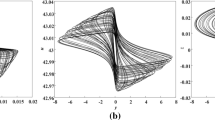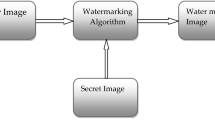Abstract
Robust reversible watermarking algorithms for images have good performance against traditional image processing methods such as compression, noise and filtering. However, when the sender transmits a carrier image over a noisy channel, the quality of the image is significantly affected and the receiver has difficulty recovering the secret information. To address this problem, we change the carrier of secret information from image to channel coding and propose a channel coding information hiding scheme based on uniform cyclic shift algorithm for images. The proposed algorithm, which is not based on a specific protocol, uses the error correction capability of the code to construct a covert channel. The secret information is embedded in the carrier bitstream approximately uniformly by the proposed algorithm, which makes the noise caused by the secret information similar to the random noise of the channel at low signal-to-noise ratio (SNR). We experimentally and analytically give the optimal values of some adjustable parameters and deduce the maximum embedding capacity of the proposed algorithm. Compared with the traditional robust reversible information hiding scheme, the carrier obtained by channel decoding at the receiving end can be the closest to the original carrier, and the secret information can be restored with the lowest bit error rate (BER).











Similar content being viewed by others
References
Abd El-Latif AA, Abd-El-Atty B, Hossain MS et al (2018) Efficient quantum information hiding for remote medical image sharing. IEEE Access 6:21075–21083. https://doi.org/10.1109/ACCESS.2018.2820603
Alattar AM (2004) Reversible watermark using the difference expansion of a generalized integer transform. IEEE Trans Image Process 13(8):1147–1156. https://doi.org/10.1109/TIP.2004.828418
Al-Qerem A, Alauthman M, Almomani A, Gupta BB (2020) IoT transaction processing through cooperative concurrency control on fog–cloud computing environment. Soft Comput 24(8):5695–5711. https://doi.org/10.1007/s00500-019-04220-y
An L, Gao X, Li X, Tao D, Deng C, Li J (2012) Robust reversible watermarking via clustering and enhanced pixel-wise masking. IEEE Trans Image Process 21(8):3598–3611. https://doi.org/10.1109/TIP.2012.2191564
Coatrieux G, Pan W, Cuppens-Boulahia N et al (2013) Reversible watermarking based on invariant image classification and dynamic histogram shifting. IEEE Trans Inf Forensics Secur 8(1):111–120. https://doi.org/10.1109/TIFS.2012.2224108
Coltuc D (2011) Improved embedding for prediction-based reversible watermarking. IEEE Trans Inf Forensics Secur 6(3 PART 2):873–882. https://doi.org/10.1109/TIFS.2011.2145372
De Vleeschouwer C, Delaigle JF, Macq B (2003) Circular interpretation of bijective transformations in lossless watermarking for media asset management. IEEE Trans Multimed 5(1):97–105. https://doi.org/10.1109/TMM.2003.809729
Dragoi IC, Coltuc D (2014) Local-prediction-based difference expansion reversible watermarking. IEEE Trans Image Process 23(4):1779–1790. https://doi.org/10.1109/TIP.2014.2307482
Dragoi I, Coltuc D (2015) On local prediction based reversible watermarking. IEEE Trans Image Process 24(4):1244–1246. https://doi.org/10.1109/TIP.2015.2395724
Dragoi IC, Coltuc D (2016) Adaptive pairing reversible watermarking. IEEE Trans Image Process 25(5):2420–2422. https://doi.org/10.1109/TIP.2016.2549458
Esposito C, Ficco M, Gupta BB (2021) Blockchain-based authentication and authorization for smart city applications. Inf Process Manag 58(2):102468. https://doi.org/10.1016/j.ipm.2020.102468
Gao X, An L, Yuan Y et al (2011) Lossless data embedding using generalized statistical quantity histogram. IEEE Trans Circuits Syst Video Technol 21(8):1061–1070. https://doi.org/10.1109/TCSVT.2011.2130410
Grabska I, Szczypiorski K (2013) Steganography in WiMAX networks. In: International Congress on Ultra Modern Telecommunications and Control Systems and Workshops. pp. 20–27
Harley PMB, Tummala M, McEachen JC (2019) High-throughput covert channels in adaptive rate wireless communication systems. In: International Conference on Electronics, Information, and Communication. pp. 1–7
Huang FJ, Huang JW, Shi YQ (2016) New framework for reversible data hiding in encrypted domain. IEEE Trans Inf Forensics Secur 11(12):2777–2789. https://doi.org/10.1109/Tifs.2016.2598528
Ishtiaq M, Ali W, Shahzad W, Jaffar MA, Nam Y (2018) Hybrid predictor based four-phase adaptive reversible watermarking. IEEE Access 6:13213–13230. https://doi.org/10.1109/ACCESS.2018.2803301
Li D, Deng L, Bhooshan Gupta B, Wang H, Choi C (2019) A novel CNN based security guaranteed image watermarking generation scenario for smart city applications. Inf Sci (Ny) 479:432–447. https://doi.org/10.1016/j.ins.2018.02.060
Li X, Li B, Yang B, Zeng T (2013) General framework to histogram-shifting-based reversible data hiding. IEEE Trans Image Process 22(6):2181–2191. https://doi.org/10.1109/TIP.2013.2246179
Li X, Zhang W, Gui X, Yang B (2013) A novel reversible data hiding scheme based on two-dimensional difference-histogram modification. IEEE Trans Inf Forensics Secur 8(7):1091–1100
Li X, Zhang W, Gui X, Yang B (2015) Efficient reversible data hiding based on multiple histograms modification. IEEE Trans Inf Forensics Secur 10(9):2016–2027. https://doi.org/10.1109/TIFS.2015.2444354
Ma H, Yi X, Wu X, et al (2014) A capacity self-adaption information hiding algorithm based on RS code. In: Processing of 2014 International Conference on Multisensor Fusion and Information Integration for Intelligent Systems. IEEE, pp 1–8
Mehta AM, Lanzisera S, Pister KSJ (2008) Steganography in 802.15.4 wireless communication. In: 2nd International Symposium on Advanced Networks and Telecommunication Systems pp 4–6
Ni Z, Shi YQ, Ansari N et al (2008) Robust lossless image data hiding designed for semi-fragile image authentication. IEEE Trans Circuits Syst Video Technol 18(4):497–509. https://doi.org/10.1109/TCSVT.2008.918761
Ou B, Li X, Zhao Y, Ni R, Shi YQ (2013) Pairwise prediction-error expansion for efficient reversible data hiding. IEEE Trans Image Process 22(12):5010–5021. https://doi.org/10.1109/TIP.2013.2281422
Paul G, Mukherjee I (2010) Image sterilization to prevent LSB-based steganographic transmission. arXiv e-prints arXiv:1012.5573
Peng F, Li X, Yang B (2012) Adaptive reversible data hiding scheme based on integer transform. Signal Process 92(1):54–62. https://doi.org/10.1016/j.sigpro.2011.06.006
Petitcolas FAP, Anderson RJ (1999) Evaluation of copyright marking systems. Proc Int Conf Multimed Comput Syst 1:574–579. https://doi.org/10.1109/mmcs.1999.779264
Petitcolas FAP, Anderson RJ, Kuhn MG (1998) Attacks on copyright marking systems. In: Second International Workshop on Information Hiding. pp 218–238
Qin C, Chang CC, Huang YH, Liao LT (2013) An inpainting-assisted reversible steganographic scheme using a histogram shifting mechanism. IEEE Trans Circuits Syst Video Technol 23(7):1109–1118. https://doi.org/10.1109/TCSVT.2012.2224052
Qin JQ, Huang FJ (2019) Reversible data hiding based on multiple two-dimensional histograms modification. IEEE Signal Process Lett 26(6):843–847. https://doi.org/10.1109/Lsp.2019.2909080
Shi YQ, Li X, Zhang X, Wu HT, Ma B (2016) Reversible data hiding: advances in the past two decades. IEEE Access 4:3210–3237. https://doi.org/10.1109/ACCESS.2016.2573308
Tewari A, Gupta BB (2017) Cryptanalysis of a novel ultra-lightweight mutual authentication protocol for IoT devices using RFID tags. J Supercomput 73(3):1085–1102. https://doi.org/10.1007/s11227-016-1849-x
Tian J (2003) Reversible data embedding using a difference expansion. IEEE Trans Circuits Syst Video Technol 13(8):890–896. https://doi.org/10.1109/TCSVT.2003.815962
Wang X, Li X, Pei Q (2020) Independent embedding domain based two-stage robust reversible watermarking. IEEE Trans Circuits Syst Video Technol 30(8):2406–2417. https://doi.org/10.1109/TCSVT.2019.2915116
Wang X, Li X, Yang B, Guo Z (2010) Efficient generalized integer transform for reversible watermarking. IEEE Signal Process Lett 17(6):567–570. https://doi.org/10.1109/LSP.2010.2046930
Wang J, Ni J, Zhang X, Shi YQ (2017) Rate and distortion optimization for reversible data hiding using multiple histogram shifting. IEEE Trans Cybern 47(2):315–326. https://doi.org/10.1109/TCYB.2015.2514110
Weng S, Pan JS (2016) Integer transform based reversible watermarking incorporating block selection. J Vis Commun Image Represent 35(November):25–35. https://doi.org/10.1016/j.jvcir.2015.11.005
Weng S, Zhang G, Pan JS, Zhou Z (2017) Optimal PPVO-based reversible data hiding. J Vis Commun Image Represent 48(May):317–328. https://doi.org/10.1016/j.jvcir.2017.05.005
Yin Z, Xiang Y, Zhang X (2020) Reversible data hiding in encrypted images based on multi-MSB prediction and Huffman coding. IEEE Trans Multimed 22(4):874–884. https://doi.org/10.1109/TMM.2019.2936314
Yu C, Li J, Li X, Ren X, Gupta BB (2018) Four-image encryption scheme based on quaternion Fresnel transform, chaos and computer generated hologram. Multimed Tools Appl 77(4):4585–4608. https://doi.org/10.1007/s11042-017-4637-6
Zeng XT, Di Ping L, Pan XZ (2010) A lossless robust data hiding scheme. Pattern Recogn 43(4):1656–1667. https://doi.org/10.1016/j.patcog.2009.09.016
Zhang W, Hu X, Li X, Yu N (2013) Recursive histogram modification: establishing equivalency between reversible data hiding and lossless data compression. IEEE Trans Image Process 22(7):2775–2785. https://doi.org/10.1109/TIP.2013.2257814
Zielińska E, Szczypiorski K (2011) Direct sequence spread spectrum steganographic scheme for IEEE 802.15.4. In: Processings of 3rd International Conference on Multimedia Information Networking and Security. pp 586–590
Zou L, Sun J, Gao M, Wan W, Gupta BB (2019) A novel coverless information hiding method based on the average pixel value of the sub-images. Multimed Tools Appl 78(7):7965–7980. https://doi.org/10.1007/s11042-018-6444-0
Author information
Authors and Affiliations
Corresponding author
Additional information
Publisher’s note
Springer Nature remains neutral with regard to jurisdictional claims in published maps and institutional affiliations.
Rights and permissions
About this article
Cite this article
Yu, K., Chen, L., Wang, Y. et al. A channel coding information hiding algorithm for images based on uniform cyclic shift. Multimed Tools Appl 81, 11279–11300 (2022). https://doi.org/10.1007/s11042-022-12034-8
Received:
Revised:
Accepted:
Published:
Issue Date:
DOI: https://doi.org/10.1007/s11042-022-12034-8




